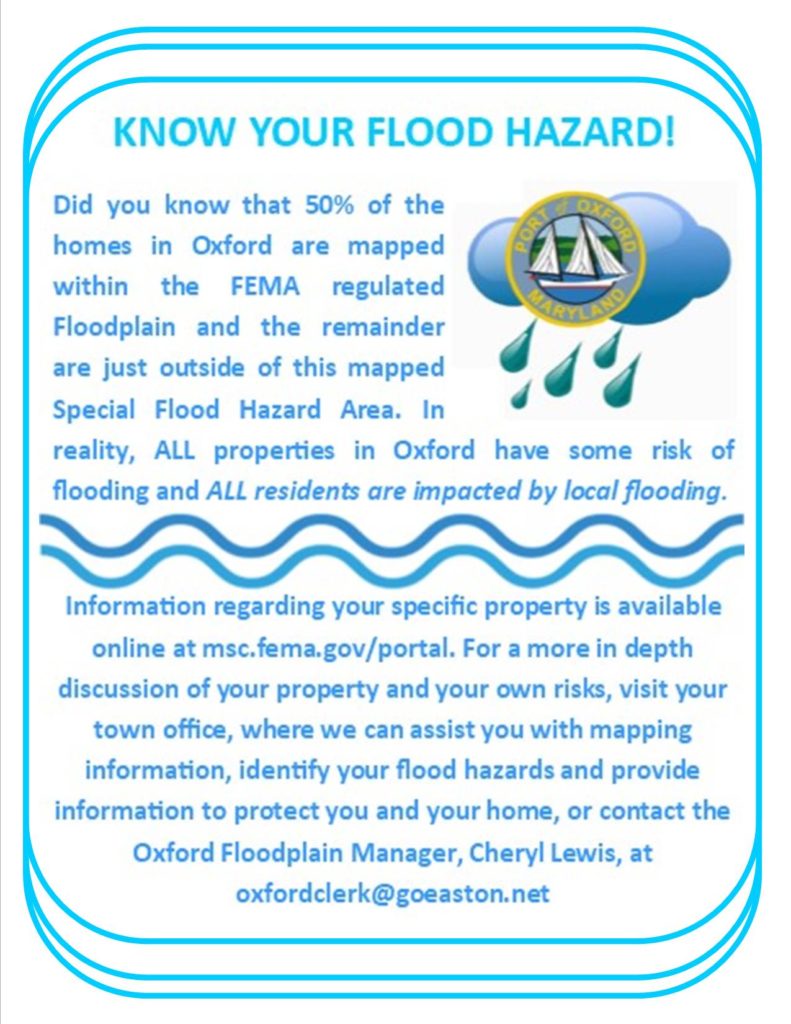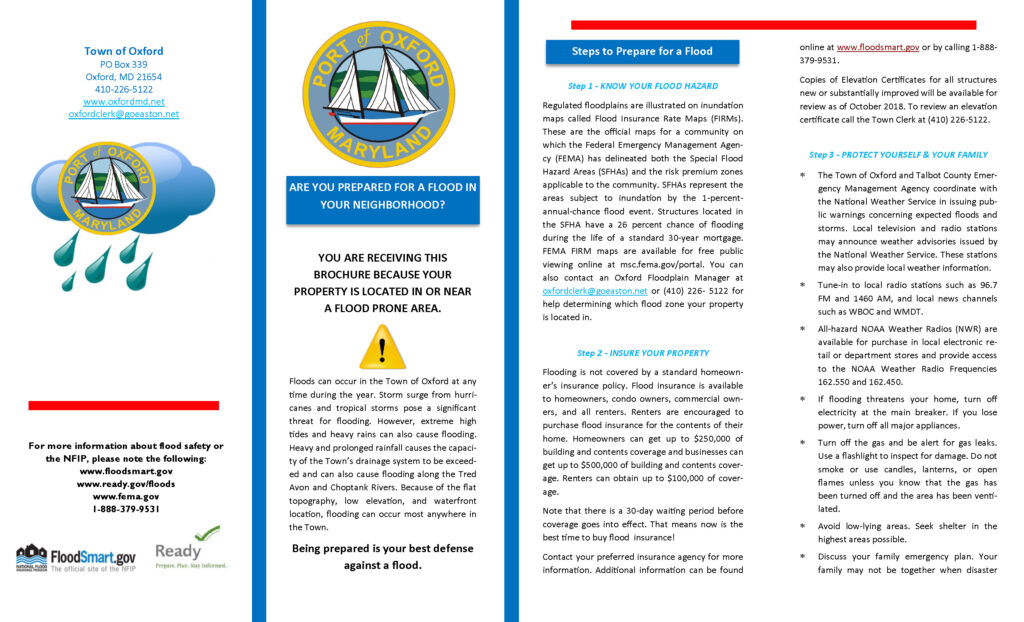
FLOODPLAIN MAPPING
The current FEMA Flood Insurance Rate Map designation for your property can be unofficially located by address on the Interactive Talbot County Flood Risk Map located at this link: http://www.talbotcountymd.gov/index.php?page=gis-maps The Quick Search button will allow you to search by address. Contact the Oxford Floodplain Manager at 410-226-5122 or oxfordclerk@goeaston.net with any questions or for assistance.
National Flood Insurance Program Information Websites:
https://www.floodsmart.gov/
https://www.fema.gov/national-flood-insurance-program
FEMA – www.ready.gov has excellent information for disasters: including the following hurricane preparation guide: httphttps://www.ready.gov/hurricanes and the following flood preparation guide: https://ww w.ready.gov/floods

PROTECTING YOUR PROPERTY WITH GREEN INFRASTRUCTURE:
Green Book for the Buffer:
https://dnr.maryland.gov/criticalarea/Documents/GreenBook_Buffer.pdf
Critical Area Buffer Resources Guide:
https://dnr.maryland.gov/criticalarea/Documents/CriticalArea_BufferResourcesGuide.pdf
Critical Area Bay Smart:
https://dnr.maryland.gov/criticalarea/Documents/baysmart.pdf
Native Plants for Wildlife Habitat and Conservation Landscaping:
https://www.fws.gov/chesapeakebay/pdf/NativePlantsforWildlifeHabitatandConservationLandscaping.pdf
Critical Area Backyard Makeover:
https://dnr.maryland.gov/criticalarea/Documents/BackyardMakeover.pdf
FLOOD INSURANCE AND FLOOD PREPAREDNESS
What is a Flood Zone?
A flood zone is an area designated on the Flood Insurance Rate Map (FIRM) that is provided to the Town of Oxford by FEMA This map shows the chance properties have of being impacted by flooding during a major weather or flood event.
Development requirements for properties located in the designated Zones can be found in the Town’s Floodplain Ordinance, along with the Oxford Zoning Ordinance and the associated Building Codes.
What are the Flood Zones?
Flood zones as shown on the FIRM are areas that are scientifically determined using a Flood Insurance Study (FIS) to predict where water will go during a major flooding event. This designate area, Special Flood Hazard Area (SFHA). is often referred to as the 100-year flood, or more accurately the area with a one percent 1% or greater chance of flooding in any given year. The zones shown on the FIRM that are most likely to impact development in Oxford are:
- Zone AE – Special Flood Hazard Area subjected to inundation by the 1 % annual chance flood.
- Zone VE – Coastal High Hazard Area: An area of special flood hazard extending from offshore to the inland limit of a primary frontal dune along an open coast and any other area subject to high velocity wave action from storms.
- LiMWA – Coastal A Zone: An area within a special flood hazard area, landward of a coastal high hazard area (V Zone) or landward of a shoreline without a mapped coastal high hazard area, in which the principal source(s) of flooding are astronomical tides and storm surges, and in which, during base flood conditions, the potential exists for breaking waves with heights greater than or equal to 1.5 feet. The inland limit of the Coastal A Zone is delineated on the FIRM as the Limit of Moderate Wave Action (LiMWA).

What Flood Zone requires flood insurance?
Normally flood insurance is required by lenders for properties located within any of the zones above. It is recommended that all property owners obtain flood insurance within the Town of Oxford as the risk of some type of flooding exist for everyone.
How do I find out what flood zone I am in?
You can look up your own property at the FEMA Map Service Center https://msc.fema.gov/portal or you can use the Talbot County Flood Mapping Tool at http://www.talbotcountymd.gov/index.php?page=gis-maps or you can contact the town office and we can map your property for you and also provide additional information regarding risk for your area.
Common Flooding Types and Definitions
Precipitation Flooding – Occurs when rain intensity exceeds capacity of our storm drain systems due volume in combination with high tide.
Storm Flooding – Is caused by storm surges resulting from events such as hurricanes and nor’easters and is directly related to land elevation and proximity to the shoreline. High tides magnify this storm damage.
Tidal Flooding – Is caused by tidal variations and is directly related to land elevation and proximity to the shoreline. Tidal flooding may occur on a regular basis due to normal moon cycles and is exacerbated by wind speeds and directions, sea level rise, and other types of flooding.
Flood Mitigation
Flood Mitigation involves cost-effective measures taken now to avoid the loss of life and reduce future damages to public facilities, homes, and other improved property. By implementing flood mitigation measures you may prevent future damage to your property resulting from flood and potentially lower your flood insurance premium.
- Elevation of your residential home to a determined Flood Protection Elevation
- Installation of proper type and quantity of Flood Vents for your structures
- Drainage improvements on your property to reduce stormwater flooding impacts
Click here to download: Oxford Flood Preparedness Brochure 2023

What is Sunny Day Tidal Flooding and what do you need to know?
From the US Climate Resilience Toolkit:
During extremely high tides, the sea literally spills onto land in some locations, inundating low-lying areas with seawater until high tide has passed. Because this flooding causes public inconveniences such as road closures and overwhelmed storm drains, the events were initially called nuisance flooding. To help people understand the cause of these events, they are now referred to as high-tide floods.
High-tide flooding is generally very localized, occurring at a scale of city blocks. By definition, a high-tide flooding event occurs when local sea level temporarily rises above an identified threshold height for flooding, in the absence of storm surge or riverine flooding. The heights of locally identified flooding thresholds are related to impacts such as standing water on low-lying roads or seawater entering stormwater systems.
Recently, sea level experts at NOAA looked at existing flood thresholds and found a pattern in the thresholds based upon tide range. They applied that pattern nationwide to develop a consistent way to monitor minor, moderate, and major high-tide flooding, even at locations without tide gauges. Documenting these floods using consistent methodology gives NOAA a way to communicate the increasing frequency of high-tide flooding to the public.1
When coastal storms coincide with high tides, the depth and extent of coastal flooding can increase dramatically. Even relatively weak winds blowing toward land during high-tide events can push huge volumes of water inland. Rainfall can also add a substantial volume of water to high-tide floods.
Extreme High Tides
Tides that are much higher than usually occur a few times per year during new and/or full moons. These perigean spring tides—also known as king tides—are astronomical in origin: they occur when the Moon’s regular orbit brings it to its closest distance to Earth (called perigee) during a new or full moon, when the Earth, Moon, and Sun are in a straight line. The combined gravitational force of the Moon and Sun on the Earth’s oceans results in the higher-than-usual tide level. Checking NOAA’s Annual State of High-Tide Flooding and Outlook or the Tides and Currents Seasonal Bulletin to learn when perigean spring tides will occur in the next year, and then raising public awareness of potential flooding before it occurs, is a step toward resilience.
